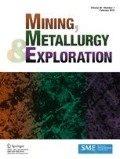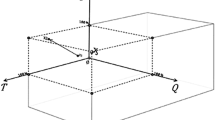Abstract
The growing availability of information and data analysis capabilities of recent years provides new opportunities for improving the performance of mining operations. By using real-time measurements and artificial intelligence, it is possible to respond faster to changing conditions, while accurate and timely information permits rapid evaluation of changes and fast business improvement decisions. This article presents a blueprint for alignment of systems, organizational design, and management practices to leverage these developments in performance-driven operations management in mining and mineral processing. The first component of the blueprint is a performance framework with a system of key performance indicators for production control that can be used across organizational levels. This system places improvement at the core of management activities, giving greater importance to improvement skills at lower organizational levels, so companies can leverage available information for improving operational control. Secondly, the blueprint defines an organizational structure that strengthens performance improvement with technological and change management capabilities. Finally, the blueprint proposes alignment of management practices, covering the optimization of short-interval controls, the application of an improvement project portfolio management system that determines the ownership of improvement projects, and the coordination of controls across the organization. This combination of systems, organizational design, and management alignment supports rapid decision-making at the right organizational level. Introduction of the presented blueprint for operations management enables mines to leverage the developments in information and analysis capabilities to improve the performance of operations.






Similar content being viewed by others
References
Hirt A (2010) Imperial mines and quarries in the Roman world: organizational aspects, 1st edition, Oxford University Press
Gupta M, Galloway K (2003) Activity-based costing/management and its implications for operations management. Technovation 23(2):131–138
Whittle J (1988) Beyond Optimization in Open Pit Design. Proc First Can Conf Comp Appl Min Ind 331–337
Copeland TE, Koller T, Murrin J (1990) Valuation: measuring and managing the value of companies. Wiley, New York
Hitomi K (2017) Manufacturing systems engineering, a unified approach to manufacturing technology, production management and industrial economics. 2nd edn, Taylor & Francis;
McKinsey & Company (2015) How digital innovation can improve mining productivity. McKinsey Metals & Mining November 2015
Busby JS, Williams GM (1993) The value and limitations of using process models to describe the manufacturing organizations. Int J Prod Res 9:2179–2194
Benndorf J, Buxton M (2016) Sensor-based real-time resource model reconciliation for improved mine production control – a conceptual framework. Min Technol 125(1):54–64
McKinsey & Company (2016) Transforming operations management for a digital world. McKinsey Operations October 2016
Tank DM (2015) Enable better and timelier decision-making using real-time business intelligence system. IJ Inf Eng Electron Bus 1:46
Kang N, Cong Z et al (2016) A hierarchical structure of key performance indicators for operation management and continuous improvement in production systems. Int J Prod Res 54(21):6333–6350
Bititci U, Carrie A, McDevitt L (1997) Integrated performance measurement systems: a development guide. Int J Oper Prod Manag 17(5):522–534
Hayes RH (1981) Why Japanese factories work. Harv Bus Rev 1981:57–66
Deloitte Development LLC (2017) Tech trends 2018 – the symphonic enterprise. Deloitte Insights, www.deloitte.com/insights/us/en/focus/tech-trends/2018/tech-trends-introduction.html. Accessed 21 December 2018
Jurisch C et al (2014) Which capabilities matter for successful business process change? Bus Process Manag J 20(1):47–67
Jones G, George J (1998) Essentials of contemporary management, 1st edn, McGraw-hill.
Barr R, Cook RE (2009) Mining for operational excellence. Min Eng 2009(11):17–22
Huotari K, Hamari H (2017) A definition for gamification: anchoring gamification in the service marketing literature. Electr Mark 27:21–31
PriceWaterhouse Coopers LLC (2012) Strategic portfolio management – how governance and financial discipline can improve portfolio performance. PriceWaterhouseCoopers press.
KPMG International (2013) Being the best: inside the intelligent finance function. KPMG Publication 130662
Acknowledgements
I thank Terry Briggs and Johan van Huyssteen for their insights and useful discussions on the topic of operations management.
Author information
Authors and Affiliations
Corresponding author
Ethics declarations
Conflict of Interest
The authors declare that they have no conflict of interest.
Additional information
Publisher’s Note
Springer Nature remains neutral with regard to jurisdictional claims in published maps and institutional affiliations.
Rights and permissions
About this article
Cite this article
Visser, W.F. A Blueprint for Performance-Driven Operations Management. Mining, Metallurgy & Exploration 37, 823–831 (2020). https://doi.org/10.1007/s42461-020-00199-5
Received:
Accepted:
Published:
Issue Date:
DOI: https://doi.org/10.1007/s42461-020-00199-5




